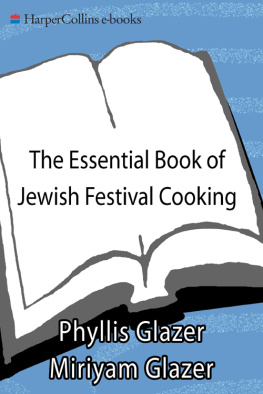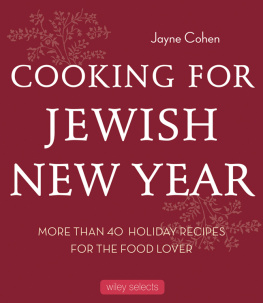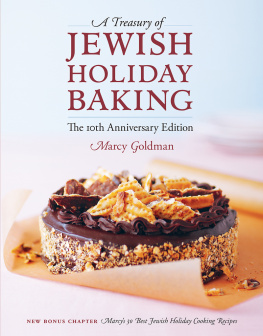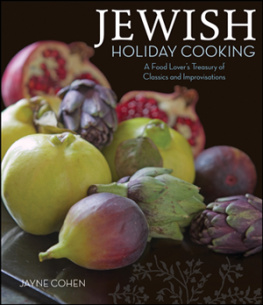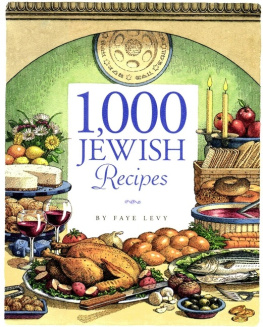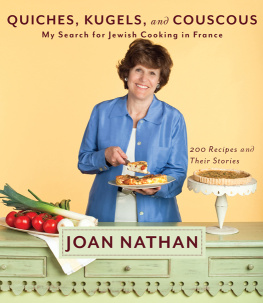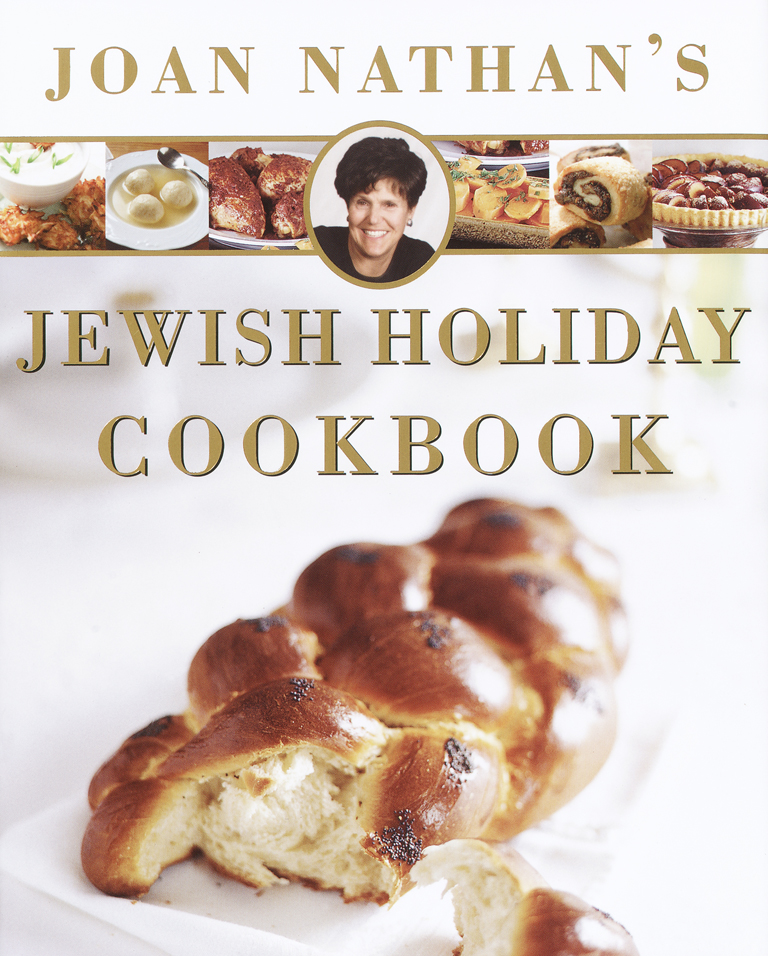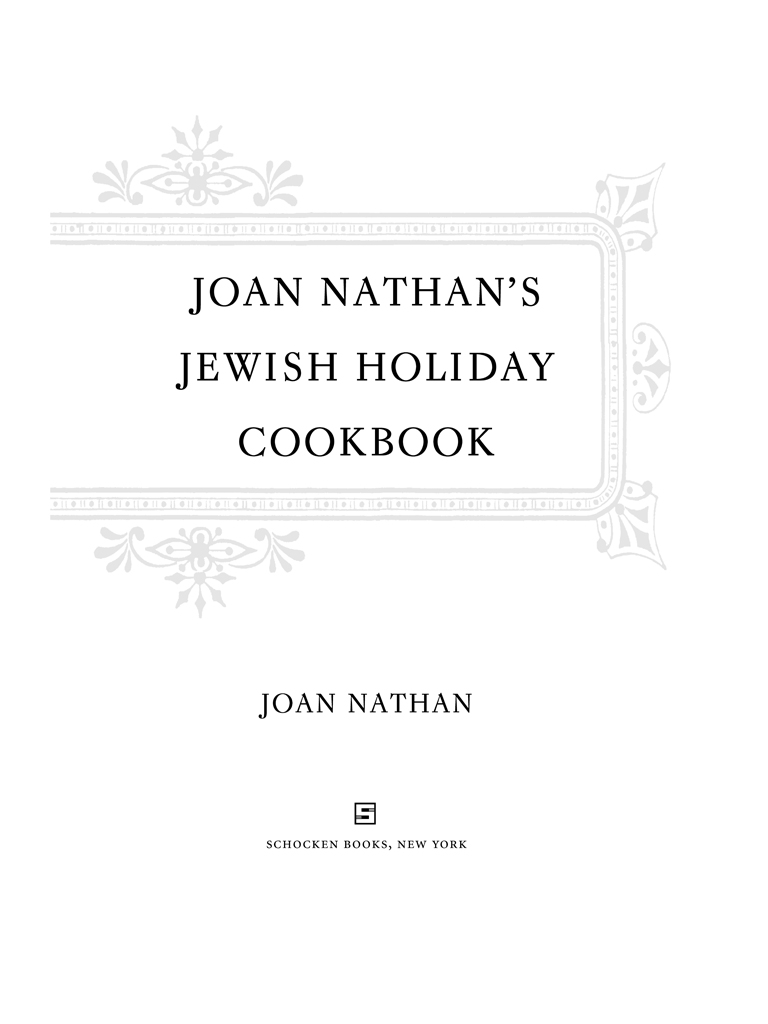Copyright 2004 by Joan Nathan
All rights reserved under International and Pan-American Copyright Conventions. Published in the United States by Schocken Books, a division of Random House, Inc., New York, and simultaneously in Canada by Random House of Canada Limited, Toronto. Distributed by Pantheon Books, a division of Random House, Inc., New York.
Schocken and colophon are registered trademarks of Random House, Inc.
This work includes all text, recipes, and drawings from The Jewish Holiday Kitchen, published by Schocken Books, a division of Random House, Inc., New York, in 1988. Copyright 1988 by Joan Nathan. It also includes much of the text and recipes from The Jewish Holiday Baker, published by Schocken Books, a division of Random House, Inc., New York, in 1997. Copyright 1997 by Joan Nathan.
Grateful acknowledgment is made to the following for permission to reprint previously published material: Crown Publishers: Excerpt from Two Shalachmones from Tevyes Daughters by Sholem Aleichem. Copyright 1949 by the Children of Sholem Aleichem and Crown Publishers, a division of Random House Inc. Reprinted by permission of Crown Publishers, a division of Random House Inc. Jonathan David Publishers, Inc.: Excerpt from The Sephardic Kosher Kitchen by Suzy David. Copyright 1984. Reprinted by permission of Jonathan David Publishers, Inc., Middle Village, N.Y. 11379. www.jdbooks.com. Curt Leviant: Excerpt from Dreydl, The Passover Eve Vagabonds, and Geese by Sholem Aleichem, translated by Curt Leviant. Copyright 1968, 2002 by Curt Leviant. Reprinted by permission of Curt Leviant, author of Ladies and Gentlemen, the Original Music of the Hebrew Alphabet and Weekend in Mustara. Edda Servi Machlin: Recipes for Italian Matzah, Il Bollo, and Ceciarchiata Taiglach adapted from The Classic Cuisine of the Italian Jews, volume 1 by Edda Servi Machlin (Giro Press, Croton-on-Hudson, N.Y., 1981). Adapted by permission of the author. The University of Chicago Press: Excerpt from The Baklava Story from Folktales from Israel by D. Noy. Copyright 1963 by The University of Chicago. Reprinted by permission of The University of Chicago Press.
Library of Congress Cataloging-in-Publication Data
Nathan, Joan.
Joan Nathans Jewish holiday cookbook: revised and updated on the occasion of the twenty-fifth anniversary of the publication of the Jewish holiday kitchen / Joan Nathan.Rev. and updated.
p. cm.
a cookbook that combines the Jewish holiday kitchen and the Jewish holiday baker Pref.
Includes bibliographical references and index.
eISBN: 978-0-307-77785-0
1. Cookery, Jewish. 2. Holiday cookery. I. Title: Jewish holiday cookbook. II. Nathan, Joan. Jewish holiday kitchen. III. Nathan, Joan. Jewish holiday baker. IV. Title.
TX724.N37 2004 641.5676dc22 2003060640
www.schocken.com
Book design by M. Kristen Bearse
v3.1
TO ALL THE WOMEN AND MEN OF VALOR
WHO HAVE PASSED DOWN THESE RECIPES
AND TO MY CHILDREN,
DANIELA, MERISSA, AND DAVID,
WHO WILL INHERIT THEM
CONTENTS
PREFACE
It hardly seems possible that twenty-five years have gone by since the publication of The Jewish Holiday Kitchen. But this year does not mark a milestone just for me. This year we celebrate the three hundred and fifty years that have passed since the first Jews arrived in America. It is, therefore, a special honor that Schocken Books chose to publish my comprehensive new cookbook as Joan Nathans Jewish Holiday Cookbook to mark this momentous occasion, a cookbook that combines both The Jewish Holiday Kitchen and The Jewish Holiday Baker, as well as a selection of the articles I have written for the New York Times over the last twenty-five years.
The Jewish Holiday Kitchen has brought me great joy through the years, due in no small part to the wonderful feedback I have received from readers and people I have met in my travels on the lecture circuit. Hundreds of others have written me lettersthough now most send e-mailwith their own family recipes, many of which have been included in subsequent editions of this book. Recipes come from so many countries: Mexico, Yemen, Algeria, Bulgaria, Poland, Russia, Egypt, and Israel, just to name a few. Some of them, such as the Yemenite High Holiday Soup Stew, may date back to the time of the Queen of Sheba. Some are the last vestige of families of Holocaust survivors, who brought to this country recipes that became a testament to those family members who were destroyed, recipes that now, as then, serve as a reminder of what we have lost. How many times people have come up to me and told me that they wished they had taken the time to watch a parent or grandparent cook! They are thrilled to find their lost family recipes in my cookbook.
To write The Jewish Holiday Kitchen, which first appeared in 1979, I tracked down the best Jewish cooks I could find. The men and women cooks were often already in their seventies or eighties. Measuring cups and spoons in hand, I spent hours, sometimes days, watching them cook and learning their techniques. And I listened to their stories, trying as best I could to record their oral histories with their recipes. Even though we have so many updated recipes these days, I am thrilled that the dishes in this book have stood the test of time and will always, I hope, be with usto help us celebrate our holidays and to comfort us throughout the year. Sadly, many of the men and women who contributed to The Jewish Holiday Kitchen have now passed away, but their wonderful dishes remain as tasty memories of the Jewish past. This is their legacy to us.
The last quarter century has been an extraordinarily productive time in the Jewish cookbook world. In 1979, the Library of Congress, which houses the worlds largest collection of books, listed no more than one hundred Jewish cookbooks, from here or anywhere else in the world, in their entire catalogue. Since then, more than three hundred new Jewish cookbooks have been added to the Librarys collection. This does not include most of the cookbooks published by sisterhood and other organizations. Titles cover nearly every ethnic cuisine: Kurdish, Italian, Moroccan, Turkish, South African, Bulgarian, and more. Cookbooks for Jewish vegetarians are now available, as are cookbooks in Hebrew devoted to kugels and pashtidot. Claudia Rodens comprehensive The Book of Jewish Food, Elizabeth Ehrlichs Miriams Kitchen, and Cara DaSilvas In Memorys Kitchen, which captures the spirit of women who perished in Theresienstadt, are among the greatest contributions to our understanding of the importance of food.
In the Jewish cooking of Borscht Belt boardinghouses and Lower East Side delis, it was usually Mama who cooked home-style stuffed cabbage and brisket in the back room. Gradually, as business improved, outside cooks began to take over the kitchen, but they served the same family-style food. Today there is a new breed of young American superstar chefsmany of whom just happen to be Jewishmen and women with college educations who have chosen the profession as their creative outlet. Sometimes these chefs draw upon their Jewish roots when crafting their menus. And at their own holiday tables, traditional recipes, with regional variations, invariably find a place. These are among the recipes I have included. As Julia Child told me recently, in the old days the cookbook writers set the pace. Now it is the chefs.



